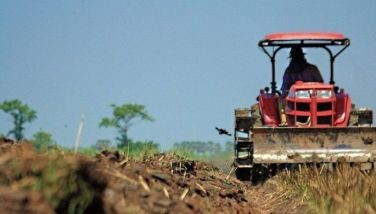Basilan growers try new seaweed variety
November 9, 2003 | 12:00am
MALUSO, Basilan – Former combatants of the Moro National Liberation Front (MNLF) who are farming seaweed in this Western town of Basilan will soon be planting a variety that is seen to be more suitable to their site.
Called the Sacol variety of Katunay (Kappaphycus sp.), this type of seaweed is found to be more sturdy and can withstand the water condition of Maluso which is murky and slightly brackish due to the surrounding tributary sources of water like rivers and streams.
"The recent study commissioned by the Livelihood Enhancement and Peace (LEAP) Program recommended the use of Sacol variety which thrives better in muddy water compared to the Tambalang variety (Kappaphycus alvarezii)," said Natalie Macawaris, LEAP program aquaculture specialist.
Members of the Batungal Seaweed Growers Association, an organization of 50 former MNLF combatants are farming Tambalang variety in the area, through the assistance of the LEAP Program. The introduction of the Sacol variety will be an addition to their current production of more than 52 metric tons of dried seaweed every 45 days.
The LEAP program is a US Agency for International Development (USAID)-funded project aimed at assisting former MNLF combatants attain commercial level production of corn, rice, or seaweed.
"Another advantage of his variety is its resistance to "ice-ice," a seaweed condition that appears as soft-whitish spots on the seaweed that causes breakage and eventual loss of the plant," Macawaris added.
Since 1997, LEAP program, with the support of other partner-agencies, has assisted some 23,000 former combatants, and has provided post-harvest facilities and community development assistance to some 570 communities where former MNLF combatants and their families reside.
"The LEAP program, in collaboration with the British government, is introducing new techniques and methods to increase the seaweed production of its participants in the Maluso area," said Noel Ruiz, LEAP program manager.
He added that the introduction of the Sacol variety is expected to further boost the participants’ seaweed production and assure them of better harvest and bigger earnings.
Carrageenan, a gelling agent that is extracted from seaweed, is among the top export products of the Philippines. Widely used in the food, pharmaceutical, beverage and the cosmetic industries, the ingredient also exhibits a wide range of properties that can be used as thickener, stabilizer, emulsifier in both food and non-food products.
The Philippines is one of the world’s largest producer of carrageenan-producing seaweed, followed by other Asian countries. Western Mindanao is the largest supplier of seaweed in the country, cornering more than 70 percent of the total supply.
Called the Sacol variety of Katunay (Kappaphycus sp.), this type of seaweed is found to be more sturdy and can withstand the water condition of Maluso which is murky and slightly brackish due to the surrounding tributary sources of water like rivers and streams.
"The recent study commissioned by the Livelihood Enhancement and Peace (LEAP) Program recommended the use of Sacol variety which thrives better in muddy water compared to the Tambalang variety (Kappaphycus alvarezii)," said Natalie Macawaris, LEAP program aquaculture specialist.
Members of the Batungal Seaweed Growers Association, an organization of 50 former MNLF combatants are farming Tambalang variety in the area, through the assistance of the LEAP Program. The introduction of the Sacol variety will be an addition to their current production of more than 52 metric tons of dried seaweed every 45 days.
The LEAP program is a US Agency for International Development (USAID)-funded project aimed at assisting former MNLF combatants attain commercial level production of corn, rice, or seaweed.
"Another advantage of his variety is its resistance to "ice-ice," a seaweed condition that appears as soft-whitish spots on the seaweed that causes breakage and eventual loss of the plant," Macawaris added.
Since 1997, LEAP program, with the support of other partner-agencies, has assisted some 23,000 former combatants, and has provided post-harvest facilities and community development assistance to some 570 communities where former MNLF combatants and their families reside.
"The LEAP program, in collaboration with the British government, is introducing new techniques and methods to increase the seaweed production of its participants in the Maluso area," said Noel Ruiz, LEAP program manager.
He added that the introduction of the Sacol variety is expected to further boost the participants’ seaweed production and assure them of better harvest and bigger earnings.
Carrageenan, a gelling agent that is extracted from seaweed, is among the top export products of the Philippines. Widely used in the food, pharmaceutical, beverage and the cosmetic industries, the ingredient also exhibits a wide range of properties that can be used as thickener, stabilizer, emulsifier in both food and non-food products.
The Philippines is one of the world’s largest producer of carrageenan-producing seaweed, followed by other Asian countries. Western Mindanao is the largest supplier of seaweed in the country, cornering more than 70 percent of the total supply.
BrandSpace Articles
<
>
- Latest
Latest
Latest
April 10, 2024 - 5:12pm
By Ian Laqui | April 10, 2024 - 5:12pm
March 4, 2024 - 3:32pm
By Ian Laqui | March 4, 2024 - 3:32pm
March 4, 2024 - 2:12pm
By Kristine Daguno-Bersamina | March 4, 2024 - 2:12pm
February 17, 2024 - 2:31pm
February 17, 2024 - 2:31pm
February 13, 2024 - 7:17pm
By Ian Laqui | February 13, 2024 - 7:17pm
Recommended




























